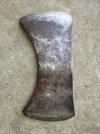- Joined
- Sep 11, 2012
- Messages
- 1,036
The BladeForums.com 2024 Traditional Knife is ready to order! See this thread for details:
https://www.bladeforums.com/threads/bladeforums-2024-traditional-knife.2003187/
Price is $300 $250 ea (shipped within CONUS). If you live outside the US, I will contact you after your order for extra shipping charges.
Order here: https://www.bladeforums.com/help/2024-traditional/ - Order as many as you like, we have plenty.


By advice, I was more meaning if someone notices something I should do or something I missed, I could use the advice on what to fix or do.

